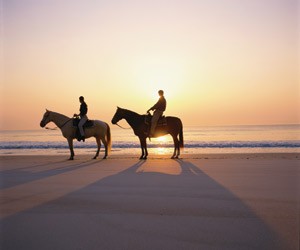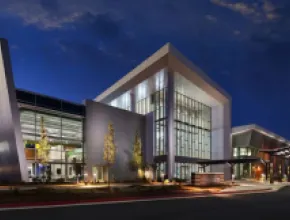There’s a first time for everything.
When Spanish explorer Juan Ponce de Leon first sighted a lush coastline of thick vegetation and beautiful beaches, he named the new land "florida" or "flowery one."
Today, a first look at the verdant northeast corner of the Sunshine State might inspire a new vocabulary—"beach getaway," "golf mecca," "natural paradise" and, thanks to Ponce de Leon and those early explorers, "historical treasure."
"When people think of Florida, they think of South Beach and Orlando," says Kristi Hansman, conference sales manager for the St. Augustine, Ponte Vedra & The Beaches Visitors & Convention Bureau (VCB). "But once they’ve done all of that, it’s nice to go to a different kind of destination."
Jacksonville
Gateway to the Sunshine State and billing itself as the place "where Florida begins," Jacksonville holds the distinction of being the largest city in the contiguous U.S.—covering 848 square miles—and yet the city never overwhelms. For one thing, Jacksonville’s size is matched by its urban parks system—also touted as the largest in the nation—with 111,600 acres set aside for getting away from it all at places like the Timucuan Ecological & Historic Preserve, one of the last unspoiled coastal wetlands on the Atlantic Coast.
Jacksonville also boasts an incredible coastline of beaches and beachfront hotels, set a comfortable drive away from Interstate 95 and the city’s downtown convention hub.
"We always fight the perception that we’re more inland," says Mya Surrency, interim president and CEO of Visit Jacksonville, the marketing arm of the Duval County TDC. (Former director John Reyes resigned last spring; a permanent replacement is due this month). "Knowing that we have more than 20 miles of beaches and a quality resort product is the message we’re trying to get out there. People are really surprised when they see the geography of Jacksonville."
Part of that geographical convenience is Jacksonville’s compact and navigable downtown area, set on the banks of the St. Johns River and fronted by a number of convention-ready properties, including the Hyatt Regency Jacksonville Riverfront, the Crowne Plaza Jacksonville Riverfront, the Omni Jacksonville and the Wyndham Jacksonville Riverwalk. Nearby are a number of large-scale meeting venues, among them the Jacksonville Veterans Memorial Arena, the Times-Union Center for the Performing Arts and the Prime F. Osborn III Convention Center, offering 275,000 square feet of flexible meeting space.
The Prime Osborn, in fact, is the focus of Visit Jacksonville’s new Convention Center Alliance, an initiative developed to streamline the center’s booking process and encourage the development of citywide conventions using multiple downtown venues.
"It really looks at how to book downtown Jacksonville from the planner’s perspective, so the planner signs one contract instead of 20," Surrency notes.
Weeks after the Alliance’s launch, Visit Jacksonville had already booked two groups, including a citywide medical convention, which dovetails nicely with the TDC’s concentration on medical meetings.
As an added incentive to book any property—downtown, golf, beach or airport—Visit Jacksonville has brought back its Cash for Contracts program, which rewards $5 for every room contracted from June to December, 2010 and 2011, with a minimum booking of 50 room nights. "It’s been wildly successful," Surrency says. "We’ve done a tremendous amount of business and the planners really appreciate the incentive."
Amelia Island
Heading northeast from Jacksonville, a trek through the dense forest and winding byways of Big and Little Talbot Islands leads to Amelia Island, a former Victorian seaport and vacation playground, whose compact size (13 miles by two miles) belies its wealth of diversions, from paddling through tranquil salt marshes—coming face-to-face with egrets, herons and maybe even a dolphin or two—to saddling up at the island’s working ranch and taking a guided horseback tour along the magnificent shoreline.
Outdoor playground that it is, Amelia Island properties get down to business with copious meeting space, highlighted in a new digital meeting planner and dedicated planner website—www.MeetOnAmelia.com—both recently launched by the convention and visitors bureau.
"We have dedicated more resources to the meetings market," says Gil Langley, president and CEO of the Amelia Island CVB. "We have great facilities that many meeting planners aren’t aware of, so we have ramped up our efforts in key target markets."
Among those facilities are Amelia Island Plantation—recently bought by Omni Hotels—which has more than 49,000 square feet of function space; The Ritz-Carlton, Amelia Island, with 19 meeting rooms, two ballrooms and two boardrooms; Summer Beach Resort, whose Executive Retreat Center offers 2,200 square feet of multifaceted space; and the island’s newest property, Residence Inn, with meeting space for up to 90 people.
A touch of Victorian elegance accompanies meetings and breakout events at one of many bed-and-breakfast inns scattered across the island and in the historic district of Fernandina Beach, while team-building experiences are built right into the landscape, from hiking part of the six-mile trail at Fort Clinch to kayaking the island’s scenic backwaters.
St. Augustine
Something old could be something new for your group in St. Augustine, the nation’s oldest city and Florida’s most historic destination, established by Pedro Menendez de Aviles in 1565, a half-century before the Mayflower set sail.
A true portal to the past, St. Augustine is home to some of the country’s oldest structures, including Castillo de San Marcos, which dates to 1695 and is the oldest masonry fort in the continental U.S.
But these heritage sites are no mere museum pieces; many of St. Augustine’s most historic venues are available for group functions, including the Pena Peck House, which dates to 1750, and the Oldest Museum Complex, home of the state’s oldest Spanish Colonial dwelling, the Gonzalez-Alvarez House, as well as two museums and an ornamental garden. Groups can also gather on 15 acres of outside space at the Fountain of Youth Archeological Park and even take a sip of the legendary waters (from an imagined fountain) that Ponce de Leon was searching for when he landed in Florida.
Group tours are a great way to get a sense of the city’s storied past, whether on Segway, carriage ride or by foot on one of several ghost tours. Already known for their popular "pub crawl" and history, murder and mayhem tours, City Walks Guided Tours recently introduced two new tours with far less sinister themes—food and shopping. The Savory Faire highlights the tastes of St. Augustine, from tapas to desserts, while Shop St. Augustine explores the most off-the-beaten-path shops in the city.
If you want to dive even deeper into local history and customs, the VCB’s Tapestries programs are designed for total immersion into the city’s heritage, as experts lead custom-designed tours emphasizing history, art, culture and heritage. Topics might include maritime history, archaeology, glass-blowing or writing.
"When you have this kind of history, to be able to offer that in enrichment programs for attendees, it’s a great thing," says Hansman of the VCB.
You can also incorporate history into where your group stays and meets in St. Augustine. Set in the heart of the city’s historic district, the Casa Monica charms with two elegant ballrooms and the Sultan’s Pavilion, a Moroccan tent with pool and garden views.
If an oceanfront setting is preferred, Ponte Vedra Beach is 20 minutes north of St. Augustine on coastal Highway A1A. Set here on sand-sprinkled shores and towering dunes, the elegant Ponte Vedra Inn & Club—built in 1928—offers 250 rooms and a conference center that can accommodate up to 450.
About a mile south of the Ponte Vedra Inn & Club and under the same management, the Ponte Vedra Lodge & Club offers 13,000 square feet of function space, including seven meeting rooms, along with team-building programs that include corporate beach Olympics.
In Ponte Vedra, groups will not only be close to beautiful beaches but also world-class tennis and championship golf courses just inland, including the TPC Sawgrass—home to The Players Championship and home of the PGA Tour—with its iconic "island" green. It’s part of one of the state’s premier golf destinations, the Sawgrass Marriott, which also offers more than 56,000 square feet of meeting space.
"We have group properties as well as hotels that don’t have much group space, but that’s OK because a lot of the groups coming here don’t require it," Hansman notes. "They’re either coming here for educational reasons or it’s a group like the Society of Florida Archivists who don’t need much space. We do very well in the association market in this destination."
Palm Coast/Flagler County
South of St. Augustine but well removed from the surf-and-race excitement of Daytona Beach to the south, Palm Coast and Flagler County create their own corporate retreat with 20 miles of pristine beaches and more than 44 parks and preserves—five part of the Great Florida Birding Trail—where bike rides, hikes and kayak adventures are easily arranged and hard to resist.
Hotel-based meetings are hosted at Hammock Beach Resort, offering more than 80,000 square feet of indoor and oceanfront function space, along with a 117-foot event yacht, suite and villa accommodations, and signature Jack Nicklaus and Tom Watson golf courses.
For smaller groups, Hilton Garden Inn Palm Coast Town Center and a Hampton Inn & Suites are among the possibilities, while other facilities—including the Bunnell City Hall—welcome small to midsize events.






